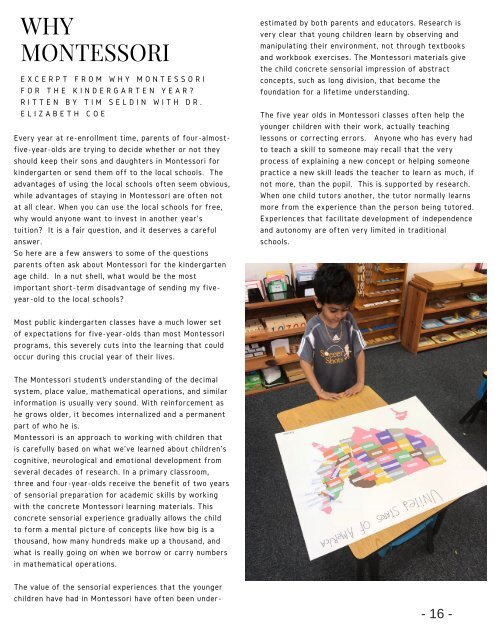Riverbend Montessori Spring 2018 Newsletter (3)
You also want an ePaper? Increase the reach of your titles
YUMPU automatically turns print PDFs into web optimized ePapers that Google loves.
WHY<br />
MONTESSORI<br />
E X C E R P T F R O M W H Y M O N T E S S O R I<br />
F O R T H E K I N D E R G A R T E N Y E A R ?<br />
R I T T E N B Y T I M S E L D I N W I T H D R .<br />
E L I Z A B E T H C O E<br />
Every year at re-enrollment time, parents of four-almostfive-year-olds<br />
are trying to decide whether or not they<br />
should keep their sons and daughters in <strong>Montessori</strong> for<br />
kindergarten or send them off to the local schools. The<br />
advantages of using the local schools often seem obvious,<br />
while advantages of staying in <strong>Montessori</strong> are often not<br />
at all clear. When you can use the local schools for free,<br />
why would anyone want to invest in another year's<br />
tuition? It is a fair question, and it deserves a careful<br />
answer.<br />
So here are a few answers to some of the questions<br />
parents often ask about <strong>Montessori</strong> for the kindergarten<br />
age child. In a nut shell, what would be the most<br />
important short-term disadvantage of sending my fiveyear-old<br />
to the local schools?<br />
estimated by both parents and educators. Research is<br />
very clear that young children learn by observing and<br />
manipulating their environment, not through textbooks<br />
and workbook exercises. The <strong>Montessori</strong> materials give<br />
the child concrete sensorial impression of abstract<br />
concepts, such as long division, that become the<br />
foundation for a lifetime understanding.<br />
The five year olds in <strong>Montessori</strong> classes often help the<br />
younger children with their work, actually teaching<br />
lessons or correcting errors. Anyone who has every had<br />
to teach a skill to someone may recall that the very<br />
process of explaining a new concept or helping someone<br />
practice a new skill leads the teacher to learn as much, if<br />
not more, than the pupil. This is supported by research.<br />
When one child tutors another, the tutor normally learns<br />
more from the experience than the person being tutored.<br />
Experiences that facilitate development of independence<br />
and autonomy are often very limited in traditional<br />
schools.<br />
Most public kindergarten classes have a much lower set<br />
of expectations for five-year-olds than most <strong>Montessori</strong><br />
programs, this severely cuts into the learning that could<br />
occur during this crucial year of their lives.<br />
The <strong>Montessori</strong> student’s understanding of the decimal<br />
system, place value, mathematical operations, and similar<br />
information is usually very sound. With reinforcement as<br />
he grows older, it becomes internalized and a permanent<br />
part of who he is.<br />
<strong>Montessori</strong> is an approach to working with children that<br />
is carefully based on what we've learned about children's<br />
cognitive, neurological and emotional development from<br />
several decades of research. In a primary classroom,<br />
three and four-year-olds receive the benefit of two years<br />
of sensorial preparation for academic skills by working<br />
with the concrete <strong>Montessori</strong> learning materials. This<br />
concrete sensorial experience gradually allows the child<br />
to form a mental picture of concepts like how big is a<br />
thousand, how many hundreds make up a thousand, and<br />
what is really going on when we borrow or carry numbers<br />
in mathematical operations.<br />
The value of the sensorial experiences that the younger<br />
children have had in <strong>Montessori</strong> have often been under-<br />
- 16 -


